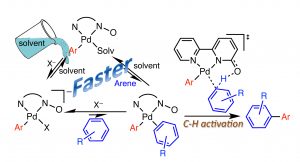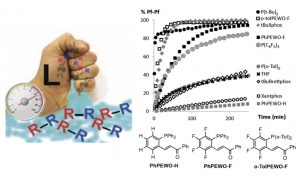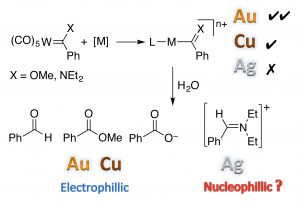[:en] Our work is intended to search for new or improved metal-catalyzed synthetic methods, related to C-C or C-X bond forming reactions. We follow two approaches that are illustrated with some examples.
New ligands to accelerate a catalytic step.
The C-H cleavage in the functionalization of arenes.
An important goal in synthesis is to substitute one or both of the conventional reagents in cross-coupling r eactions by the parent hydrocarbon. This is a formidable step towards a more sustainable catalysis that faces the challenge of effectively breaking the strong and kinetically sluggish C-H bond. We have used the [2, 2’-bipyridin]-6(1H)-one ligand (bipy-6-OH) and demonstrated its cooperative role in the C-H activation step. This ligand enables the direct arylation of simple arenes or pyridine in considerably shorter reaction times.
eactions by the parent hydrocarbon. This is a formidable step towards a more sustainable catalysis that faces the challenge of effectively breaking the strong and kinetically sluggish C-H bond. We have used the [2, 2’-bipyridin]-6(1H)-one ligand (bipy-6-OH) and demonstrated its cooperative role in the C-H activation step. This ligand enables the direct arylation of simple arenes or pyridine in considerably shorter reaction times.
V. Salamanca, A. Toledo, A. C. Albéniz. [2, 2’-Bipyridin]-6(1H)-one, a Truly Cooperating Ligand in the Palladium-Mediated C-H Activation Step: Experimental Evidence in the Direct C-3 Arylation of Pyridine”. J. Am. Chem. Soc. 2018, 140, 17851-17156. DOI: 10.1021/jacs.8b10680.
 We have also recently disclosed the accelerating role of moderately coordinative solvents, including a methyl ketone, in the direct arylation of arenes. A detailed study of the mechanism of these reactions allowed us to understand the importance of the arene coordination equilibira in the cycle and the origin of the solvent acceleration.
We have also recently disclosed the accelerating role of moderately coordinative solvents, including a methyl ketone, in the direct arylation of arenes. A detailed study of the mechanism of these reactions allowed us to understand the importance of the arene coordination equilibira in the cycle and the origin of the solvent acceleration.
V. Salamanca, A. C. Albéniz. Faster Palladium-Catalyzed Arylation of Simple Arenes in the presence of a methylketone: Beneficial effect of an a priori interfering solvent in C-H activation. Org. Chem. Front. 2021. DOI: 10.1039/D1QO00236H.
Our goal is to apply these type of cooperating pyridone ligands and other related systems to useful functionalization of arenes.
The product-forming step.
The last step in a C-C or C-X bond forming reaction catalyzed by group 10 metals is a reductive elimination. This is a crucial step since, being generally irreversible, if it is efficient it drives the preceding equilibria to a successful coupling. We hav e found that ligands designed “ad hoc” bearing σ-donor groups at one end and π-acceptors at the other are very effective at improving the reductive elimination. They have revealed themselves as good as, or even better that many bulky phosphines commonly used for the coupling of difficult substrates. The relative efficiency has been measured using the reductive elimination of C6F5-C6F5 (Pf-Pf) in [Pd(C6F5)2(THF)2].
e found that ligands designed “ad hoc” bearing σ-donor groups at one end and π-acceptors at the other are very effective at improving the reductive elimination. They have revealed themselves as good as, or even better that many bulky phosphines commonly used for the coupling of difficult substrates. The relative efficiency has been measured using the reductive elimination of C6F5-C6F5 (Pf-Pf) in [Pd(C6F5)2(THF)2].
E. Gioria, J. del Pozo, J. M. Martínez de Ilarduya, P. Espinet. “Promoting Difficult Carbon–Carbon Couplings: Which Ligand Does Best ?” Angew. Chem. Int. Ed. 2016, 55, 13276-13280.
Study of organometallic fundamental reactions involved in catalysis.
We are interested in the study of the behaviour of reactive palladium carbenes (no N, N) such as monoamino or alkoxycarbenes. Some time ago, we discovered a migratory insertion of an aryl goup to a carbene in this type of complexes that leads to a new C-C bond and a palladium oganometallic complex that can be further functionalized (Angew. Chem. Int. Ed. 2002, 41, 2363; Chem. Eur. J. 2005, 11, 1565). More recently, our work in this field is the demonstration that the migratory insertion reaction in palladium carbenes is a general process and occurs, not only for aryl groups, but also for alkyl and acyl moieties.
 I. Meana, A. C. Albéniz, P. Espinet “Acyl-Carbene and Methyl-Carbene Coupling via Migratory insertion in Palladium Complexes” Organometallics, 2012, 31, 5494-5499.
I. Meana, A. C. Albéniz, P. Espinet “Acyl-Carbene and Methyl-Carbene Coupling via Migratory insertion in Palladium Complexes” Organometallics, 2012, 31, 5494-5499.
This reaction, little studied, is important in Pd-catalyzed processes that use diazo derivatives and other carbene precursors as substrates in coupling reactions that can form several C-C bonds in one process. Our aim is to understand this bond forming process in depth.
We have also extended our studies to the behavior of late transition metal monoamino- or monoalkoxo-carbenes when a migratory insertion is not possible. By transmetalation of carbene fragments from tungsten to Cu, Ag, Au and Pd, some new carbenes can be synthesized. All the metals except Ag show the expected electrophilic character for the coordinated carbene, whereas the distinct behavior of Ag towards hydrolysis is consistent with a nucleophillic character of the carbene fragment. As group 11 carbenes are intermediates in many catalytic processes, this difference is relevant.
 I. Meana, A. Toledo, A. C. Albéniz, P. Espinet ”Detection and Reactivity of a Palladium Alkoxycarbene” Chem. Eur. J. 2012, 18, 7658.
I. Meana, A. Toledo, A. C. Albéniz, P. Espinet ”Detection and Reactivity of a Palladium Alkoxycarbene” Chem. Eur. J. 2012, 18, 7658.
A. Toledo, V. Salamanca, T. Pérez-Moro, A. C. Albéniz. Transmetalation of Acyclic Tungsten Carbenes to Coinage Metals: Distinct Behavior of Silver toward Carbene Transfer and Hydrolysis. Organometallics 2021, 40, 38-47. DOI: 10.1021/acs.organomet.0c00675.
[:es]
El objetivo de nuestro trabajo es buscar métodos sintéticos catalizados por metales nuevos o mejorados, relacionados con la formación de enlaces C-C o C-X. Seguimos dos aproximaciones, de las que se dan aquí algunos ejemplos.
Nuevos ligandos para acelerar una etapa del ciclo catalítico.
La ruptura del enlace C-H en la funcionalización de arenos.
Un objetivo importante en síntesis es sustituir uno o los dos reactivos en reacciones de acoplamiento cruzado convencio nales por el hidrocarburo correspondiente. Este es un gran paso hacia la catálisis más sostenible, pero es necesario superar el reto de romper de forma efectiva el enlace C-H, fuerte y cinéticamente inerte. Hemos usado el ligando [2, 2’-bipyridin]-6(1H)-one ligand (bipy-6-OH) y demostrado su papel cooperativo en la etapa de activación C-H. Este ligando permite la arilación directa de arenos simples o de piridina con tiempos de reaction considerablemente más cortos.
nales por el hidrocarburo correspondiente. Este es un gran paso hacia la catálisis más sostenible, pero es necesario superar el reto de romper de forma efectiva el enlace C-H, fuerte y cinéticamente inerte. Hemos usado el ligando [2, 2’-bipyridin]-6(1H)-one ligand (bipy-6-OH) y demostrado su papel cooperativo en la etapa de activación C-H. Este ligando permite la arilación directa de arenos simples o de piridina con tiempos de reaction considerablemente más cortos.
V. Salamanca, A. Toledo, A. C. Albéniz. [2, 2’-Bipyridin]-6(1H)-one, a Truly Cooperating Ligand in the Palladium-Mediated C-H Activation Step: Experimental Evidence in the Direct C-3 Arylation of Pyridine”. J. Am. Chem. Soc. 2018, 140, 17851-17156. DOI: 10.1021/jacs.8b10680.
 Hemos descubierto recientemente el efecto acelerador de disolventes moderadamente coordinantes en la arilación directa de arenos, incluida un metil cetona. Un estudio detallado del mecanismo de estas reacciones permite entender la importancia de los equilibrios de coordinación en que interviene el areno en el ciclo catalítico y el origen de la aceleración del disolvente.
Hemos descubierto recientemente el efecto acelerador de disolventes moderadamente coordinantes en la arilación directa de arenos, incluida un metil cetona. Un estudio detallado del mecanismo de estas reacciones permite entender la importancia de los equilibrios de coordinación en que interviene el areno en el ciclo catalítico y el origen de la aceleración del disolvente.
V. Salamanca, A. C. Albéniz. Faster Palladium-Catalyzed Arylation of Simple Arenes in the presence of a methylketone: Beneficial effect of an a priori interfering solvent in C-H activation. Org. Chem. Front. 2021. DOI: 10.1039/D1QO00236H
Our goal is to apply these type of cooperating pyridone ligands and other related systems to useful functionalization of arenes.
La etapa final de formación del producto.
La última etapa de una reacción que conduzca a la formación de enlaces C-C o C-X catalizada por metales del grupo 10 es la eliminación reductora. Esta es una etapa crucial ya que, siendo generalmente irreversible, si es rápida desplaza los equilibrios que se establecen en el resto del ciclo catalítico hacia un acoplamiento eficaz. Hemos encontrado que ciertos ligandos diseñados “ad hoc” y que contienen grupos σ-dadores junto con grupos π-aceptores capaces de coordinarse al metal, mejoran notablemente a elimina ción reductora. Por esta capacidad, son ligandos tan buenos o mejores que muchas fosfinas voluminosas, empleadas habitualmente para el acoplamiento de sustratos difíciles. La eficacia relativa de estos y otros ligandos se ha medido usando la reacción de eliminación reductora de C6F5-C6F5 (Pf-Pf) en el complejo [Pd(C6F5)2(THF)2].
ción reductora. Por esta capacidad, son ligandos tan buenos o mejores que muchas fosfinas voluminosas, empleadas habitualmente para el acoplamiento de sustratos difíciles. La eficacia relativa de estos y otros ligandos se ha medido usando la reacción de eliminación reductora de C6F5-C6F5 (Pf-Pf) en el complejo [Pd(C6F5)2(THF)2].
E. Gioria, J. del Pozo, J. M. Martínez de Ilarduya, P. Espinet. “Promoting Difficult Carbon–Carbon Couplings: Which Ligand Does Best ?” Angew. Chem. Int. Ed. 2016, 55, 13276-13280.
Estudio de reacciones organometálicas fundamentales que intervienen en catálisis.
Estamos interesados en el estudio del comportamiento de carbenos de paladio reactivos (no N, N-sustituidos) tales como monoamino or alcoxicarbenos. Hace algún tiempo descubrimos la reacción de inserción migratoria de un grupo arilo a un carbeno en este tipo de complejos, lo que da lugar a la formación de un nuevo enlace C-C en un complejo organometálico de paladio que se puede funcionalizar posteriormente. (Angew. Chem. Int. Ed. 2002, 41, 2366; Chem. Eur. J. 2005, 11, 1565). Más recientemente, nuestro trabajo en este campo ha sido la demostración de que la inserción migratoria en carbenos de paladio es un proceso general y ocurre, no solo en el caso de grupos arilo sino también para restos alquilo o acilo.
I. Meana, A. C. Albéniz, P. Espinet “Acyl-Carbene and Methyl-Carbene Coupling via Migratory insertion in Palladium Complexes” Organometallics, 2012, 31, 5494-5499.
Esta reacción, escasamente estudiada, es importante en los procesos catalizados por paladio que usan diazo derivados u otros precursores de carbenos como sustratos. Estas reacciones llevan a menudo a la formación de varios enlaces C-C en una misma catálisis. Nuestro objetivo es entender el proceso de formación de enlaces a través de inserción migratoria en profundidad.
También hemos extendido nuestros estudios al comportamiento de monoamino- o monoalcoxo-carbenos de metales de la derecha de la series de transición, cuando la inserción migratoria no es posible. Se pueden sintetizar alguno de estos nuevos complejos mediante transmetalación de fragmentos carbeno desde wolframio a Cu, Ag, Au y Pd. Todos los metales menos la Ag muestran el carácter electrofílico esperado para este tipo de carbenos, mientras que el comportamiento de la Ag frente a la hidrólisis es consistente con un carácer nucleofílico del carbeno. Ya que los carbenos del grupo 11 son intermedios en numerosos procesos catalíticos, esta diferencia es notable e importante.
 I. Meana, A. Toledo, A. C. Albéniz, P. Espinet ”Detection and Reactivity of a Palladium Alkoxycarbene” Chem. Eur. J. 2012, 18, 7658.
I. Meana, A. Toledo, A. C. Albéniz, P. Espinet ”Detection and Reactivity of a Palladium Alkoxycarbene” Chem. Eur. J. 2012, 18, 7658.
A. Toledo, V. Salamanca, T. Pérez-Moro, A. C. Albéniz. Transmetalation of Acyclic Tungsten Carbenes to Coinage Metals: Distinct Behavior of Silver toward Carbene Transfer and Hydrolysis. Organometallics 2021, 40, 38-47. DOI: 10.1021/acs.organomet.0c00675.